Mastering Gluten-Free Pancakes: A Complete Guide
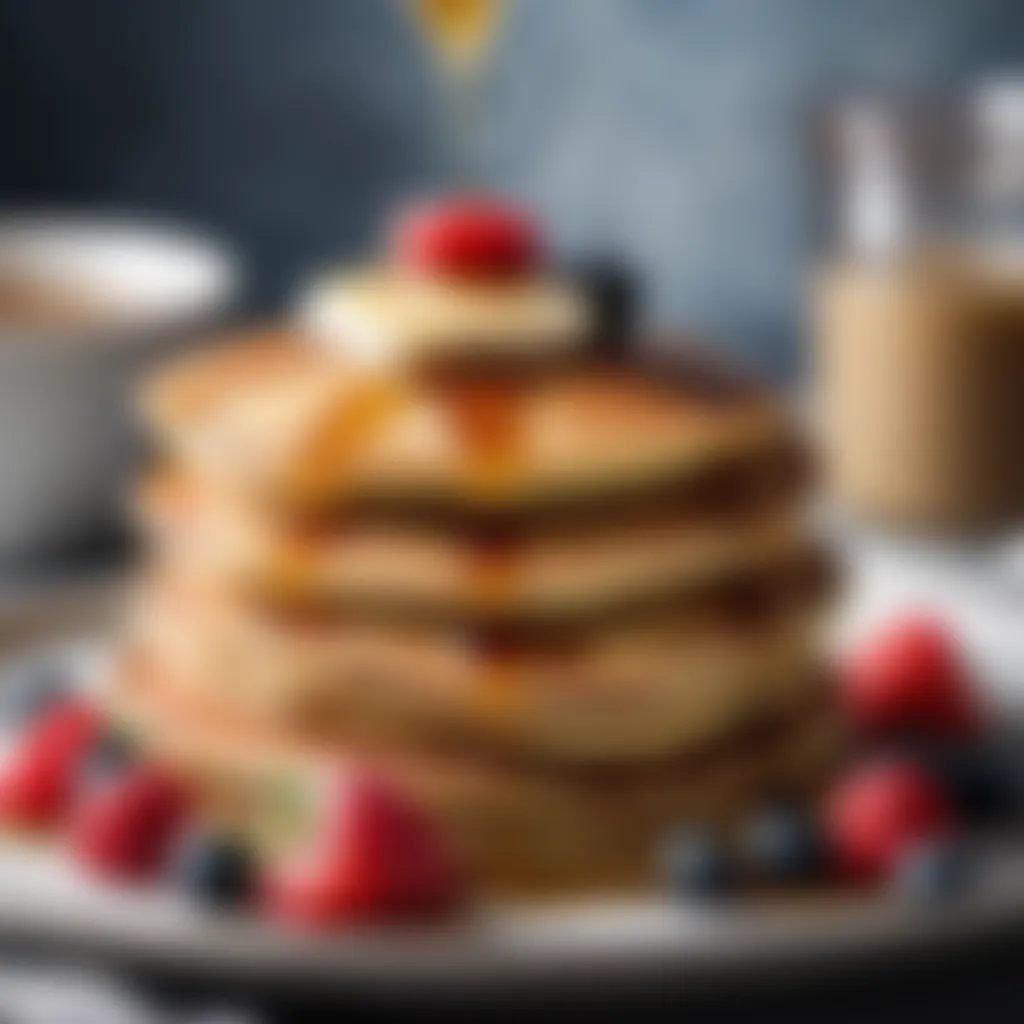
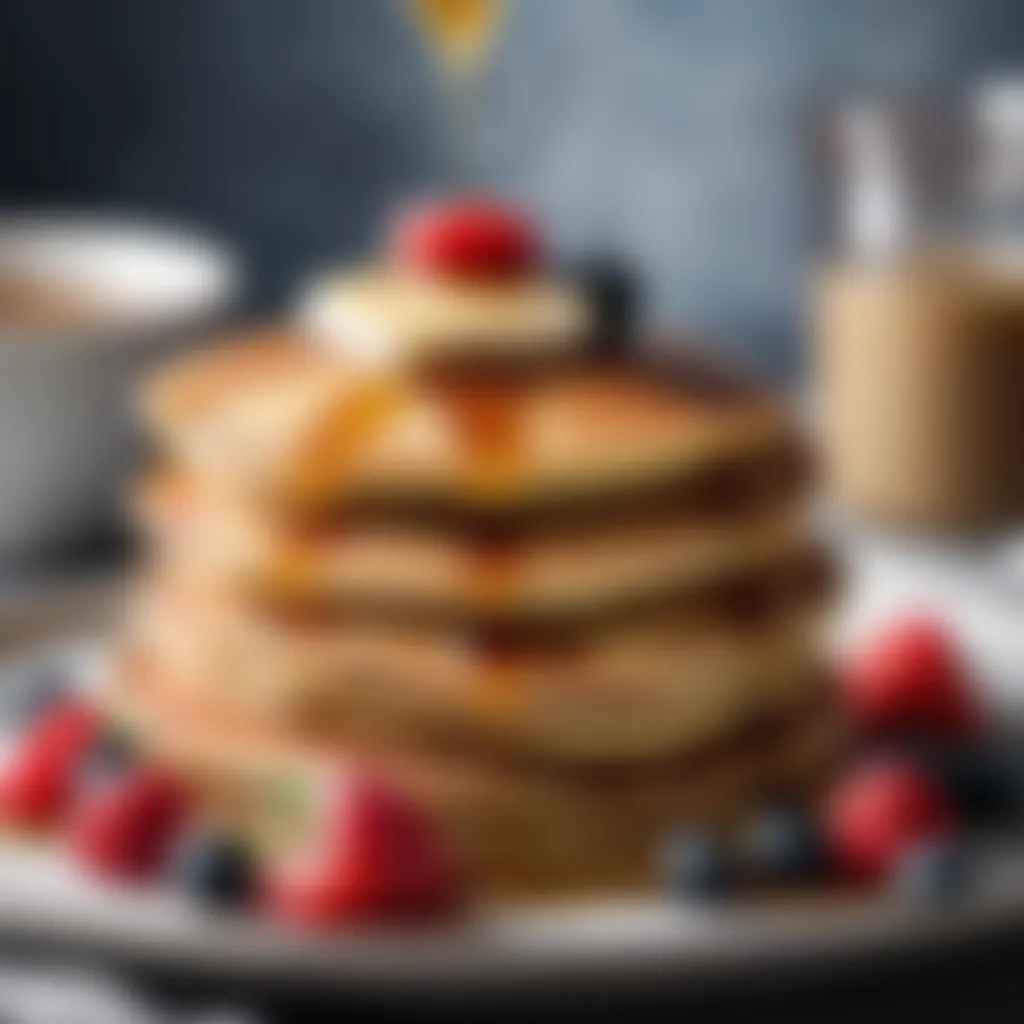
Intro
Cooking gluten-free pancakes can initially seem daunting, particularly for those used to conventional recipes. However, fear not; achieving that pillowy, delightful pancake without gluten is entirely within reach. The secret lies in understanding the fundamental differences in ingredients and techniques. In this guide, we'll explore the essential ingredients, preparation steps, and cooking techniques to help you whip up a batch of pancakes that will please even the most discerning palate.
No need for complicated culinary jargon here—just straightforward instruction that will help you create a simple yet delicious breakfast staple that adheres to gluten-free dietary needs.
Ingredients:
Gathering the right ingredients is crucial in making gluten-free pancakes. Here’s what you will need:
- 1 cup of gluten-free all-purpose flour (look for brands like Bob's Red Mill or King Arthur Flour for optimal results)
- 2 tablespoons of sugar (granulated or coconut sugar works well)
- 1 teaspoon of baking powder
- 1/2 teaspoon of baking soda
- 1/4 teaspoon of salt
- 1 cup of buttermilk (or a homemade version using milk and vinegar)
- 1 large egg
- 2 tablespoons of melted butter (or a neutral oil like canola)
- 1 teaspoon of vanilla extract (optional, but adds flavor)
These ingredients are all you need to kickstart your pancake-making prowess. Let’s take a deeper dive into how to combine them effectively.
Preparation Steps:
Step-by-Step Instructions
- Combine the Dry Ingredients: In a mixing bowl, add the gluten-free flour, sugar, baking powder, baking soda, and salt. Whisk these together until they are well integrated. This ensures that the leavening agents are evenly distributed, leading to pancakes that rise beautifully.
- Mix the Wet Ingredients:
In another bowl, whisk the buttermilk, egg, melted butter, and vanilla extract. Combine them thoroughly until you see a consistent mixture.
If you don’t have buttermilk, just mix 1 cup of milk with 1 tablespoon of vinegar and let it sit for about 5 minutes. - Combine Both Mixtures: Pour the wet mixture into the dry ingredients. Using a spatula, stir until just combined. It’s okay if the batter is a little lumpy; over-mixing can lead to tougher pancakes.
Technical Aspects:
Temperature Settings
Preheat your skillet or griddle over medium heat. The temperature should be around 350°F (175°C). A good way to test if it’s ready is to sprinkle a few drops of water on it; if they dance and evaporate, you’re set to go.
Timing Specifics
Once you pour the batter into the skillet, allow it to cook undisturbed for about 2 to 3 minutes. You’ll know it’s time to flip when bubbles form on the surface of the pancake and the edges look slightly set.
Cooking Process:
- Prepare the Cooking Surface:
Lightly grease the skillet with a bit of butter or oil to prevent sticking. - Pour the Batter:
Use a 1/4 cup measure to pour batter onto the skillet. This keeps the pancakes uniform in size. - Cook Thoroughly:
Allow the pancakes to cook for 2-3 minutes, as mentioned earlier, until the edges look firm and the center has bubbles forming. - Flip and Finish:
Flip the pancake carefully and cook for an additional 1-2 minutes on the other side until golden brown.
Troubleshooting Tips:
- If pancakes are too thick: Add a bit more buttermilk or milk to thin the batter slightly.
- If pancakes are too flat: Check that your baking powder hasn’t expired; it’s critical for fluffiness.
The beauty of gluten-free pancakes is their adaptability. Feel free to tweak your ingredients based on your pantry or taste preferences. Whether it’s adding nuts, fruit, or even chocolate chips, you hold the reins for your culinary adventure.
"Cooking is not just about the destination; it’s about enjoying the journey."
With these steps and tips, you are well on your way to create a batch of delightful pancakes that are not only gluten-free but also utterly delicious. Enjoy the process and happy cooking!
Understanding Gluten-Free Pancakes
Understanding gluten-free pancakes is a vital starting point for anyone looking to explore this alternative cuisine. For those with celiac disease or gluten sensitivity, traditional pancakes made of wheat flour can trigger significant health issues. Thus, the demand for gluten-free options is more than just a dietary need; it’s a lifestyle choice impacting many individuals and families today.
Choosing to create gluten-free pancakes opens doors to a world of diverse ingredients, flavors, and textures. Plus, it allows one to cater to varying dietary needs without sacrificing enjoyment at the breakfast table. When crafted properly, gluten-free pancakes can be just as fluffy and satisfying as their traditional counterparts, if not more so.
Also, it’s important to note that gluten serves specific functions in baking, which leads us to understand how we can replicate or even enhance those properties when going gluten-free. Substituting the right ingredients not only meets dietary restrictions but also brings a fresh twist to a beloved classic. This awareness helps in making informed choices when it comes to health, flavor, and culinary creativity.
"A cake without flour isn’t a cake at all, but a pancake without gluten can still be as delightful as a sunny morning!"
In summary, knowing about gluten-free pancakes not only prepares you for practical cooking but also informs your culinary adventures. By deeply comprehending the elements at play, you’re better equipped to whip up a breakfast that pleases everyone around the table.
Defining Gluten-Free
The term "gluten-free" refers to foods that do not contain gluten, a protein found in wheat, barley, and rye. This definition is critical, especially for those who must strictly avoid gluten due to health issues. Think of gluten as that sticky substance that gives dough its stretch and elasticity – without it, you’re exploring a whole new world of ingredients.
For pancakes, gluten-free options typically include various flours like almond, coconut, and oat flour. These ingredients offer unique flavors and textures while ensuring safety for those with gluten sensitivities. However, not every flour on the market is suitable for all people with this requirement, some are often cross-contaminated, thus making it essential to always check labels and choose certified gluten-free products.
The Role of Gluten in Traditional Pancakes
To appreciate gluten-free pancakes, it helps to understand what gluten brings to the table – quite literally. In traditional pancakes, gluten contributes to the structure and feel, allowing the batter to rise and hold together during cooking. It gives pancakes that fluffy, tender bite often desired at breakfast.
Without gluten, the texture will differ significantly, which can be daunting at first. However, many alternative ingredients can mimic this behavior to some extent. Using specific combinations of gluten-free flours that include starches (like tapioca or potato starch) can help create a more desirable texture. Essentially, it’s a process of experimentation, arriving at a blend that yields pancakes as delightful as any traditional version.
While it may seem challenging, engaging with gluten-free baking teaches patience and creativity. With the right flours and techniques, crafting gluten-free pancakes can turn into a joyous culinary adventure.
Choosing the Right Flours
Selecting the right flour can make or break your gluten-free pancake experience. It’s not just about filling a bowl with any flour you have at hand; the type of flour influences the texture, flavor, and nutritional profile of your pancakes, crucial elements when crafting the perfect breakfast. Using varied flours provides distinct benefits. Each flour type brings its unique taste and texture, while also offering different health benefits. This section explores popular gluten-free flours, highlights their features, and guides you through the best blending practices for optimal results.
Almond Flour
Almond flour often steps into the limelight for gluten-free baking because it offers a delicious, nutty flavor and excellent moisture retention. Made from finely ground almonds, this flour is not only gluten-free but also packs in a good amount of protein, healthy fats, and vitamin E.
Using almond flour can create pancakes that are rich and satisfying. However, it’s essential to remember that almond flour has a different absorption rate compared to wheat flour. Pancakes made solely with almond flour can end up too dense. That’s why, if you're aiming for light and fluffy outcomes, a careful blend with other flours is a smart move.
Coconut Flour
Coconut flour brings a tropical twist to your pancakes. This flour is derived from dried coconut meat and has a naturally sweet taste. One of the remarkable properties of coconut flour is its high fiber content, which may support digestion and help maintain a feeling of fullness.
When using coconut flour, it's crucial to exercise moderation. This flour is notorious for its absorbent nature. Just a small amount can soak up a lot of moisture, leading to a very thick batter if not balanced properly with other flours or liquids. A rule of thumb is to use only one-fourth of the amount you would normally use of other flours. This aspect makes coconut flour a fantastic option to add a bit of sweetness without overpowering your pancakes.
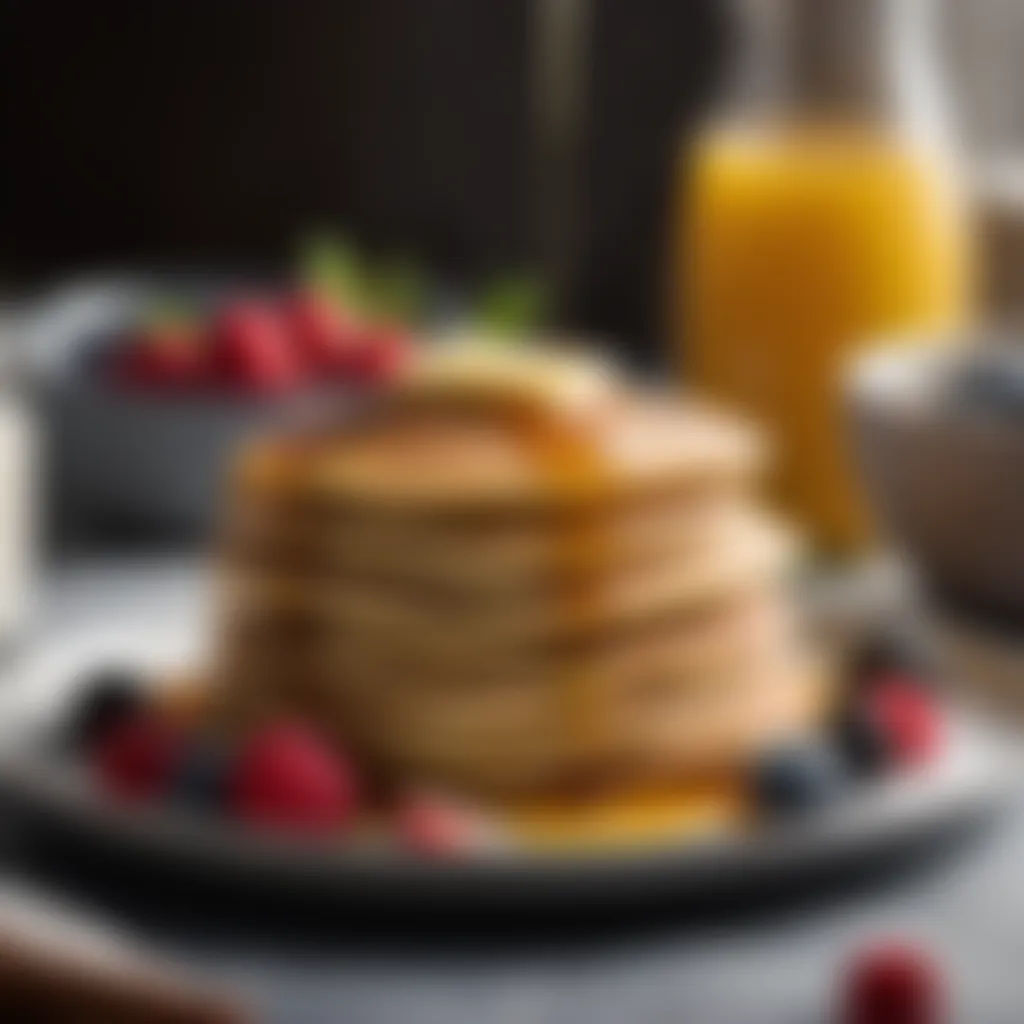
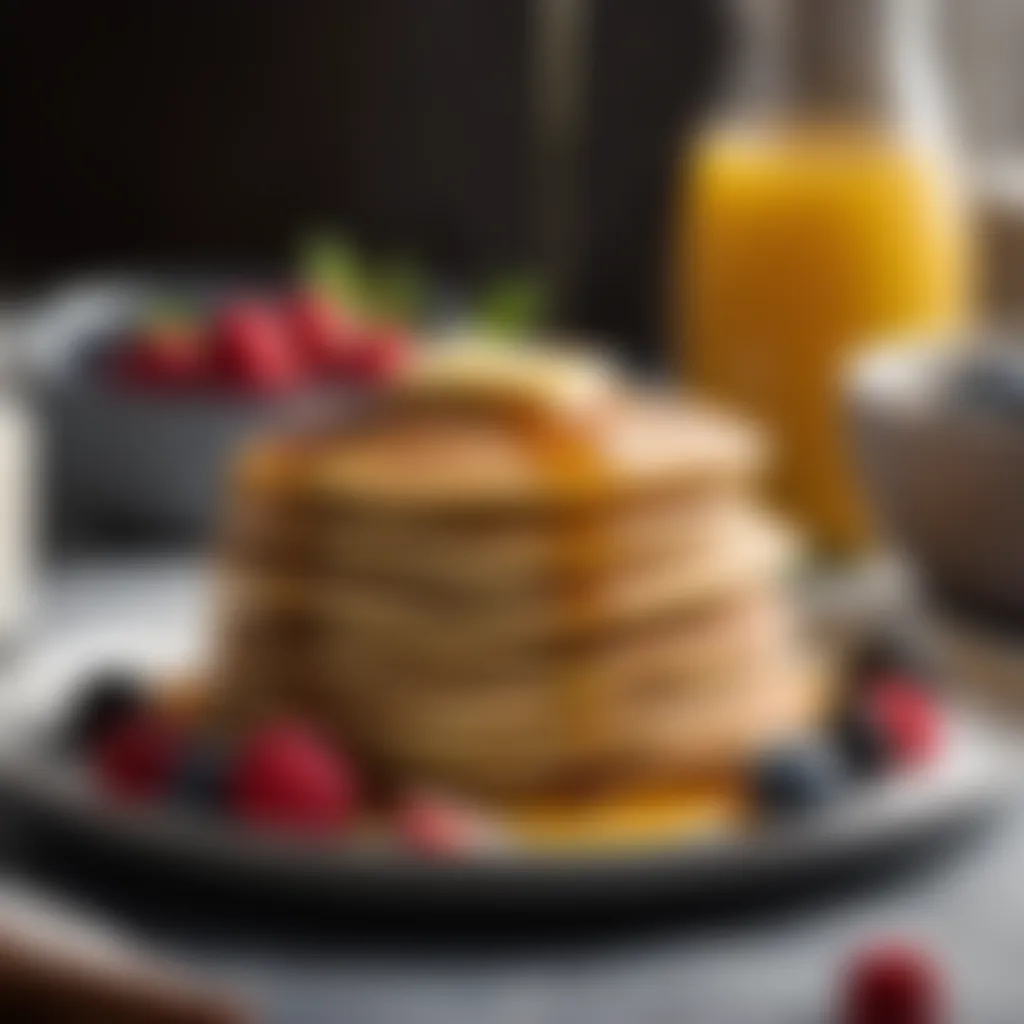
Oat Flour
Oat flour is another contender worth considering. Made from ground whole oats, it’s not only gluten-free (provided it’s certified) but also lends a mild, earthy flavor to pancakes. Oat flour is known for its ability to create a fluffy texture, often reminiscent of traditional pancake recipes.
Interestingly, oat flour is also packed with additional nutrients, like vitamins and minerals, which makes it a healthy alternative for breakfast staples. You may notice that it combines well with other flours, striking an admirable balance. For those who appreciate a bit of heartiness in their pancakes, incorporating oat flour could elevate your dish.
Blending Flours for Best Results
Creating the ideal pancake batter often means blending various flours. While using a single type can yield decent results, mixing flours usually opens up a whole new level of culinary possibilities. Each flour contributes different textures and flavors, and when they harmonize, it can lead to pancakes that are not only enjoyable but also nutritionally balanced.
For example, using a combination of almond flour and coconut flour can yield a pancake that’s both fluffy and moist. As mentioned, almond flour contributes to moisture, while coconut flour adds structure and fiber.
Here's a simple tip: if you pick two or more flours, contemplate their absorption rates. Adjust your liquid ingredients accordingly to attain the desired batter consistency.
In summary, choosing and blending the right flours is a key aspect of making delightful gluten-free pancakes. With a little knowledge and experimentation, you’ll find the perfect mix that intrigues your taste buds and meets your dietary needs.
Core Ingredients for Pancake Batter
In the realm of gluten-free pancake making, the core ingredients function like gears in a well-oiled machine. Each plays a crucial role in not just taste, but also texture, providing that perfect fluffiness we all crave. Selecting the right components can make or break your pancake experience, especially when gluten is off the table.
Eggs and Their Function
Eggs are often regarded as one of the cornerstones of pancake batter. Their contribution goes beyond mere binding; they act as a leavening agent, helping the pancakes rise and create a delightful fluff. When beat and incorporated into the batter, they introduce air, much like a kite sailing on a gusty day. In gluten-free recipes, where structure can falter due to the absence of gluten, eggs help compensate by adding stability.
Moreover, eggs provide moisture and richness, ensuring that your pancakes don't turn out dry or bland. When sourcing eggs, consider organic, free-range varieties. They guarantee not only better flavor but also higher nutritional value. So, as you crack those eggs, remember: they aren’t just ingredients; they are vital players in achieving pancake perfection.
Milk Alternatives
Finding the right milk alternative is pivotal for those who are gluten-free and perhaps dairy-free as well. Regular cows' milk might not suit everyone, but thankfully, numerous options exist. Almond milk, coconut milk, and oat milk can all seamlessly blend into your pancake batter, enhancing flavor while keeping the mixture light.
- Almond Milk: This is a popular choice due to its nutty flavor and low calorie content. It adds creaminess without the heaviness of dairy.
- Coconut Milk: If you fancy a tropical twist, coconut milk is a fantastic option. It's richer and lends a subtle sweetness that works wonders with pancakes.
- Oat Milk: Known for its smooth texture, oat milk is creamy and fabulous for achieving light, airy pancakes.
When selecting a milk alternative, consider unsweetened versions to maintain a balanced flavor profile. Mixing different milks can also yield exciting results. A little creativity goes a long way in finding that perfect blend.
Sweeteners: Natural vs. Processed
Sweetness can hugely impact your pancake's allure. While a dash of sugar might seem like the easy option, opting for natural sweeteners offers richer flavors and health benefits.
- Natural Sweeteners: Honey, maple syrup, or agave nectar can add depth. They usually carry their own flavor notes rather than just sweetness, blending beautifully with the pancake mix. Honey works particularly well when warmed, giving a lovely drizzle over your fluffy stacks.
- Processed Sugars: Common white and brown sugars can also do the job, but they lack the complexities of their natural counterparts. Processed sugars can sometimes leave a flattened flavor profile, not to mention potential health impacts from overconsumption.
When experimenting with sweeteners, it’s important to balance flavors. A little natural sweetness combined with other ingredients can yield a much more satisfying pancake experience.
Remember: The right ingredients can elevate your pancakes from ordinary to extraordinary, making every bite memorable.
The Ultimate Gluten-Free Pancake Recipe
Creating the ultimate gluten-free pancake recipe is not just about tossing together a handful of ingredients; it’s about crafting a delightful mixture that marries taste and texture. The key here is to understand the special qualities needed when working without gluten, as it plays a pivotal role in traditional pancake structures. Gluten, the protein found in wheat, offers elasticity and chewiness, which are often missed in gluten alternatives. By finding the right balance of ingredients, you can create pancakes that are fluffy, moist, and satisfyingly delicious.
This recipe will not only serve those who are gluten-intolerant but also entice anyone who is looking to switch things up in the breakfast department. Think of the taste you could miss if you overlook gluten-free options. There’s a world of flavors waiting, and a well-constructed recipe ensures that no one leaves the table feeling shortchanged.
Ingredients List
To whip up a stellar batch of gluten-free pancakes, gathering the right ingredients is crucial. Here’s what you will need:
- 1 cup almond flour – This will give your pancakes a nutty undertone while keeping them moist.
- 1/2 cup coconut flour – Adds a fluffy texture and absorbs moisture, ensuring the pancakes don’t fall apart.
- 2 teaspoons baking powder – A key leavening agent to help your pancakes rise and stay airy.
- 1/4 teaspoon salt – Enhances the overall flavor.
- 3 large eggs – These are essential for binding and enriching the flavor.
- 1 cup almond milk or other non-dairy milk – Choose your preference for a creamy texture without dairy.
- 2 tablespoons honey or maple syrup – Provides sweetness without being overwhelming.
- 1 teaspoon vanilla extract – Adds a comforting note that rounds out the flavor.
Step-by-Step Preparation
Now that you have your ingredients, let’s dive into the preparation:
- Combine the Dry Ingredients: In a large bowl, whisk together the almond flour, coconut flour, baking powder, and salt. Mixing these first helps to evenly distribute the leavening agent for a better rise.
- Mix the Wet Ingredients: In a separate bowl, beat the eggs and then stir in the almond milk, honey, and vanilla extract until combined.
- Incorporate Wet into Dry: Gradually add the wet mixture to the dry ingredients. Stir gently, ensuring you don’t overmix, which can lead to denser pancakes. Just mix until everything is blended, and a few lumps are okay.
- Let the Batter Rest: Allow your batter to sit for about 10 minutes. This resting period lets the flours hydrate, which is crucial for achieving a great texture.
Cooking Techniques for Best Results
Cooking gluten-free pancakes can be a little delicate, but with the right techniques, you can achieve the perfect flip:
- Preheat the Pan: Use a non-stick skillet or griddle, and heat it over medium-low heat. This slower cooking allows the insides to cook through without burning the outsides.
- Watch the Temperature: If your pancakes are browning too fast, lower the heat. Ideally, you want a golden-brown pancake without charred spots.
- Use a Ladle: Pour about 1/4 cup of batter onto the skillet for each pancake. This ensures uniformity in size, allowing them to cook evenly.
- Look for Bubbles: Wait until you see bubbles forming on the surface of the pancakes to know it’s time to flip. This usually takes about 2-3 minutes, depending on your heat.
Tip: Always use a spatula to gently lift the edge and peek at the underside before flipping to avoid tearing.
- Serve Immediately: Once the pancake is flipped and cooked through, transfer it to a plate. You can keep them warm in a low oven, but fresh is best.
By understanding and applying these elements effectively, you'll find that gluten-free pancakes can be just as enjoyable, if not more so, than their traditional counterparts. So roll up your sleeves and get ready to embrace a breakfast delight!
Texture Optimization Strategies
When crafting gluten-free pancakes, achieving the right texture is paramount. Unlike traditional pancakes, which benefit from gluten's binding and elasticity, gluten-free versions require a nuanced approach to ensure the pancakes remain fluffy and enjoyable. Texture optimization not only enhances the eating experience but also elevates the overall quality of the dish. It involves understanding various mixing methods, allowing the batter to rest, and adjusting thickness for the desired outcome.
Understanding Mixing Methods
Mixing is more than just combining ingredients in a bowl; it's a critical step that influences the pancake texture. When making gluten-free pancakes, it's essential to mix just enough to incorporate the ingredients without overworking the batter. Overmixing can lead to a rubbery or dense pancake, which is the last thing anyone wants when they expect a light and fluffy treat.
Incorporating dry and wet ingredients separately is often suggested. Start by whisking together dry ingredients—like almond flour, baking powder, and a pinch of salt—in one bowl, while combining wet ingredients—eggs, milk alternatives, and any flavors— in another. Gradually pour the wet into the dry, folding gently to combine. This folding action allows for air to be trapped in the batter, which is vital in creating that ideal rise during cooking.
Tip: Always use a spatula or wooden spoon for folding, as these tools are less aggressive than electric mixers and promote a light texture.
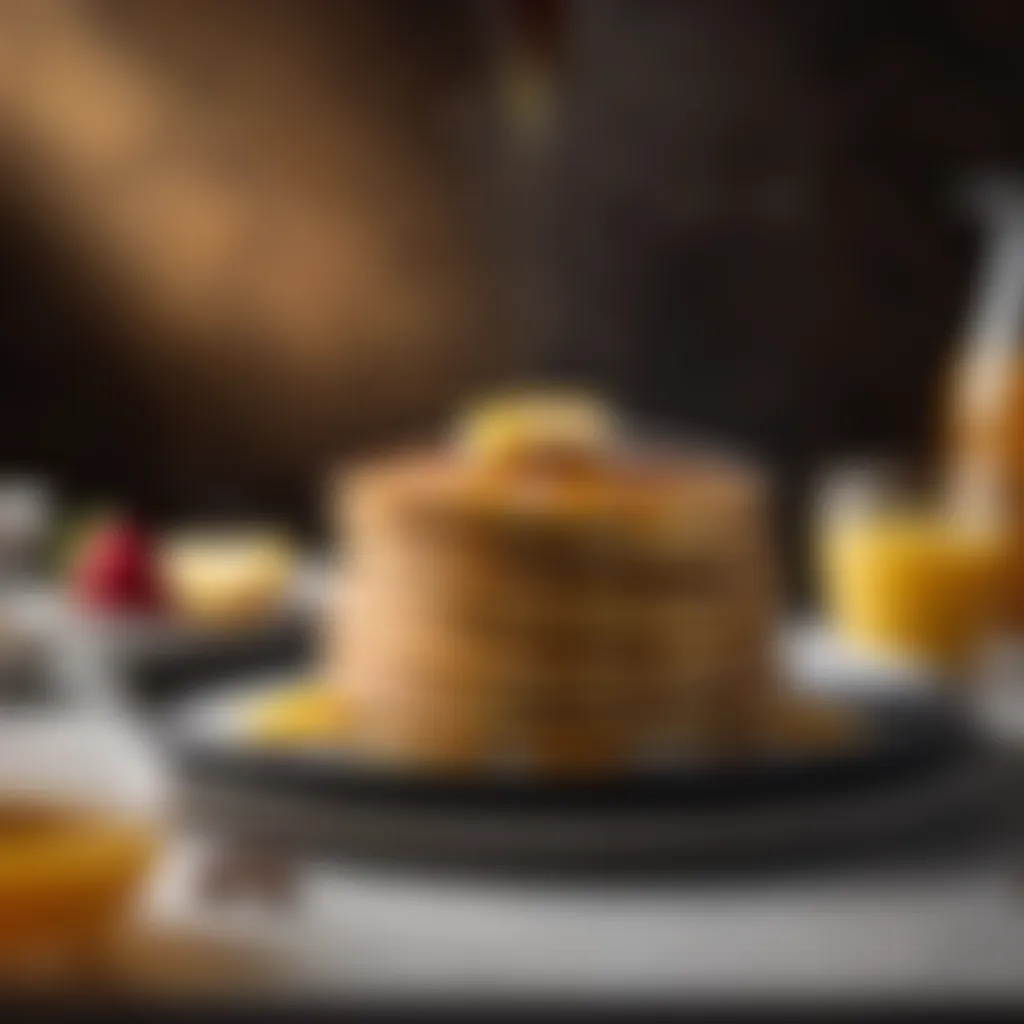
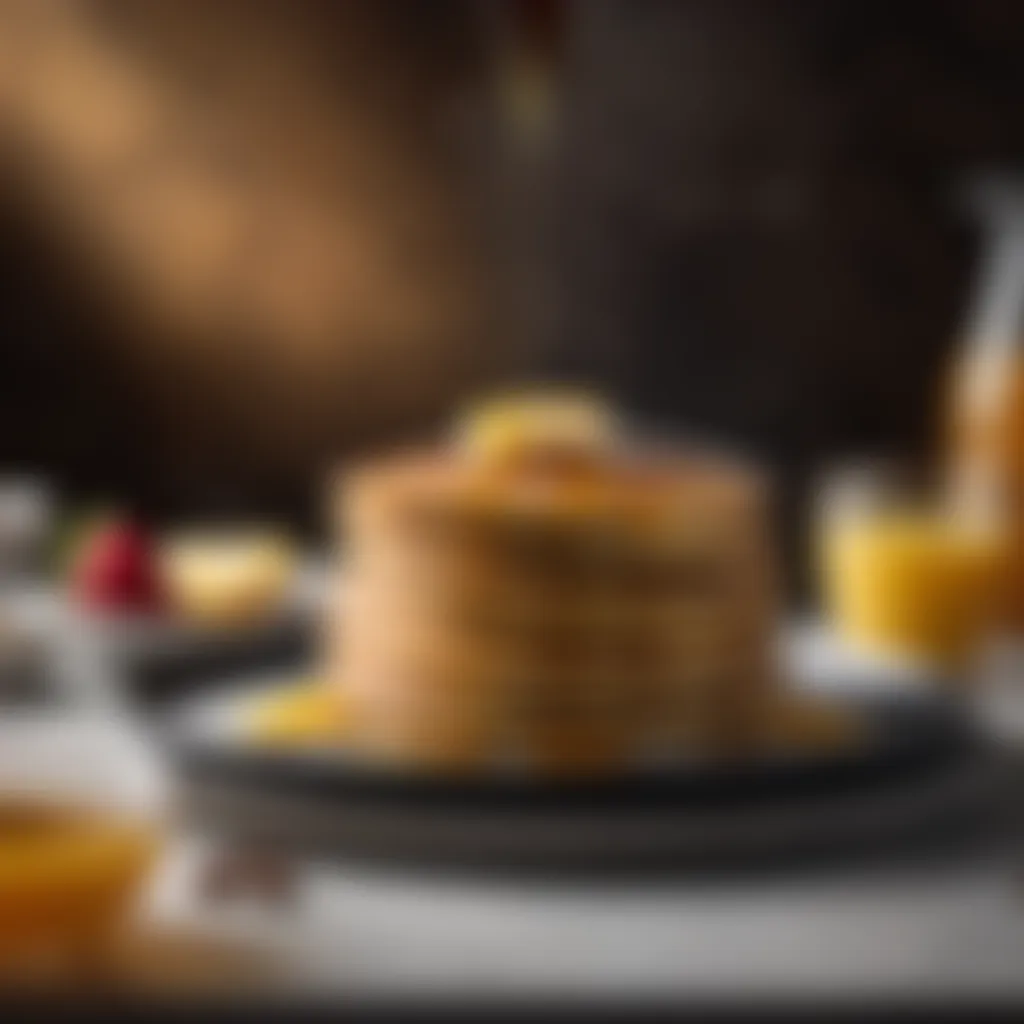
Resting the Batter
Resting the batter may seem like a minor step, but it plays a significant role in achieving the perfect pancake texture. When gluten-free flours absorb moisture, they swell and soften. Allowing the batter to sit for about 10 to 30 minutes lets the flours hydrate properly, leading to a smoother, more cohesive batter.
During this resting phase, enzyme activity increases, breaking down starches and enhancing flavor. Furthermore, letting the batter rest can result in pancakes that hold their shape better while cooking. Many seasoned cooks swear by this step; some even recommend a longer resting time for enhanced texture results.
Adjusting Thickness
The thickness of your pancake batter is pivotal. Too thin, and the pancakes won't hold their shape. Too thick, and you'll end up with dry or unevenly cooked thick flaps. The right thickness provides a nice balance, allowing for an airy texture while ensuring the pancake cooks through properly.
A general ratio to consider is adding enough liquid to achieve a pourable but not runny consistency. This typically translates to a batter that flows smoothly off a spoon but still holds its shape when dolloped onto the skillet. If the batter feels too thick, lighten it by adding a small amount of liquid, such as almond or coconut milk, gradually until the desired consistency is reached.
Common Mistakes to Avoid
When endeavoring to create the perfect gluten-free pancakes, being aware of common pitfalls can make all the difference. Mistakes during preparation and cooking can lead to disappointing results, leaving one scratching their head as to where it all went wrong. By arming yourself with knowledge about these common errors, you can elevate your pancake game to delicious heights. Let's explore two of the most frequent mistakes: overmixing the batter and incorrect cooking temperature.
Overmixing the Batter
Overmixing the pancake batter can be a deal-breaker. It’s tempting to want a smooth, uniform mixture, but too much stirring leads to gluten development, even with gluten-free flours. The result? Rubber-like, tough pancakes that are a chore to chew. Instead, aim for a just mixed consistency. You might see some lumps – that's okay. They’ll tend to incorporate and disappear during cooking.
To strike the right balance:
- Mix the dry ingredients separately from the wet ones, and fold them together gently.
- A few lumps mean moisture is still intact – that's what you want.
- Consider a spatula or wooden spoon instead of a whisk for a gentler approach.
"Remember, light mixing is your friend; it’s all about preserving the fluffiness!"
Incorrect Cooking Temperature
Temperature is another crucial factor that many overlook. Cooking too hot can cause the outside to char while the inside remains raw. Conversely, cooking at too low a temperature means you might end up with pale, flat pancakes that aren’t exactly appetizing. Finding the sweet spot is essential for achieving that golden-brown exterior while ensuring a perfectly cooked interior.
To manage your cooking temperature effectively:
- Use a non-stick skillet or griddle preheated to medium-low. A good test is to sprinkle a few drops of water; if they sizzle and evaporate after a few seconds, you’re ready.
- If you notice browning too quickly, it may be a signal to lower the heat. If they’re cooking too slowly, turn it up slightly.
By avoiding overmixing and maintaining the right cooking temperature, you set yourself on a solid path towards fluffy, satisfying pancakes that everyone will adore. Knowing these common mistakes helps cultivate not just a better cooking experience but also a rewarding one.
Delicious Variations to Explore
Exploring variations in gluten-free pancakes not only enhances the overall experience but also caters to diverse palates and dietary preferences. Incorporating a range of ingredients can transform a simple pancake into a delightful treat, making any breakfast occasion feel special. The significance of this section lies in its ability to inspire creativity. By making small tweaks or additions, the humble pancake can reflect seasonal ingredients, personal preferences, or even health considerations.
Offering variations allows one to adapt the foundational recipe to many tastes, ensuring that no two pancake breakfasts need to be alike. It might not be just about avoiding gluten; often, it's about exploring new flavor dimensions, increasing nutritional content, or accommodating food sensitivities.
Adding Fruits
When it comes to infusing flavor and natural sweetness into gluten-free pancakes, fruits are a fantastic addition. Bananas, blueberries, and shredded apples can elevate the taste and texture significantly. Imagine biting into a pancake studded with juicy berries bursting with flavors, or a warm banana pancake with a soft, caramel-like sweetness.
Consider the following points when adding fruits:
- Seasonal Choices: Using fruits that are in season can make your pancakes not only tastier but also more cost-effective.
- Texture Impact: Fruits can add moisture but be cautious. Too much moisture can lead to soggy pancakes. It's often wise to adjust other ingredients accordingly if you add particularly juicy fruits.
- Complementing Flavors: Match fruits with spices. For example, pairing cinnamon with apples can create a sense of home and warmth.
Also, you can puree fruits like mango or peaches and mix them into the batter for a smooth texture. Alternatively, top your pancakes with fresh fruits, giving a burst of freshness to each bite.
Integrating Nuts and Seeds
Nuts and seeds not only add crunch and protein, which balances the carbohydrate content of pancakes but also introduce a wealth of flavors. Incorporating chopped nuts such as walnuts, pecans, or even hazelnuts can add rich, nutty undertones, whereas seeds like chia, flax, or sunflower seeds enhance the nutritional quality.
Here are a few considerations when using nuts and seeds:
- Nutritional Boost: Nuts and seeds are rich in healthy fats, fiber, and essential nutrients. This adds depth to the pancakes’ nutritional profile, making breakfast more wholesome.
- Flavor and Texture: You can toast nuts before adding them for a robust flavor. This slight extra step can make a world of difference.
- Safety for Allergies: Be sure to consider any potential nut allergies. Offering a nut-free version of your pancake variation ensures all can enjoy.
Incorporating nuts or seeds can be as simple as folding some into the batter or sprinkling them on top before serving. With fruits, nuts, and seeds, the pancake experience opens up pathways to numerous culinary adventures.
Perfecting Pancake Toppings
Getting the toppings right can make all the difference when it comes to enjoying gluten-free pancakes. They’re not just an afterthought; they really elevate the whole dish. The way you dress your pancakes can influence not only the flavor profile but also the texture and experience of each bite. Toppings can introduce a delightful contrast to the soft, fluffy pancake, adding layers of flavor and interest.
Moreover, topping choices offer a chance to make the pancakes healthier or more decadent, depending on your mood or dietary goals. It’s like a paintbrush to a canvas, where you can express creativity and cater to specific tastes. Think of different flavors and textures as a way to complement and enhance the base pancake. With thoughtful approaches to toppings, you can transform a simple dish into something more remarkable.
Natural Syrups and Sauces
Natural syrups and sauces are often where the magic happens. A drizzle of pure maple syrup is the classic choice, and rightly so. It provides a rich sweetness that pairs wonderfully with the subtle flavors of gluten-free pancakes. But the world of natural syrups stretches way beyond this staple.
- Honey: This sweet treat can add a floral aroma and a different depth of flavor. It’s liquid gold and a healthier alternative, loaded with antioxidants.
- Agave Nectar: With its mild flavor, agave can be a great option for those looking for a syrup that won’t overpower the pancake itself.
- Fruit Purees: Think mashed strawberries or blended bananas for a fresh and vibrant slice of nature in every bite. These add moisture and a natural sweetness, offering a slightly different texture that’s quite refreshing.
- Coconut Syrup: A delicious alternative that brings a hint of tropical flair to the mix. Its caramel notes can really complement the nutty flavors often found in gluten-free flours.
Each syrup or sauce can create its own unique experience. When you pour it over your stack, envision how those flavors will meld with the fluffy pancake.
"Quality toppings are not just enhancements; they can be the highlight of your pancake experience."
Creamy and Nutty Options
Creamy and nutty toppings add richness and a lovely textural variant that can contrast beautifully with the softness of pancakes. You have a variety of options to explore here, and they can cater to different tastes.
- Nut Butters: Almond or peanut butter can bring a hearty dose of protein and creaminess. Spread a generous layer or drizzle a bit for that nutty kick that many love.
- Greek Yogurt: Pack a punch with this creamy, tangy addition. A dollop of Greek yogurt not only adds a rich texture but also gives a protein boost, balancing out your breakfast beautifully.
- Cottage Cheese: Another underappreciated option, cottage cheese gives a creamy texture while packing in plenty of protein. Its mild flavor works well with fruits or syrup.
- Whipped Cream: If you’re in the mood for something indulgent, a swirl of light whipped cream can make the pancakes feel extra special.
When combining these ingredients, think about how they interact with the sweet and nutty tones of your gluten-free pancake. A little experimentation might just reveal your next go-to topping!
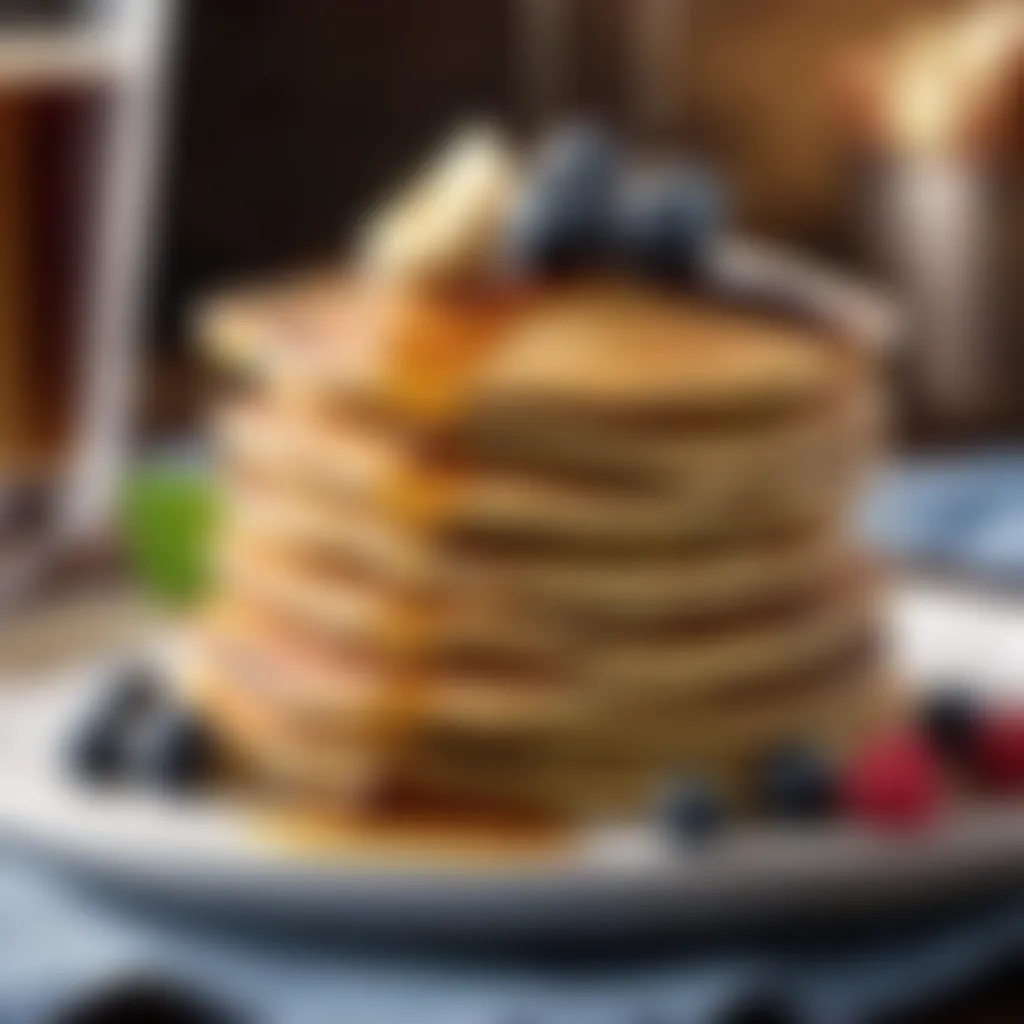

The beauty of toppings lies in their versatility. They can be simple or complex, healthy or indulgent, depending on what you feel like that day. Don't shy away from mixing and matching! Whether it’s a quick weekday breakfast or a leisurely weekend brunch, perfecting pancake toppings is a way to customize this staple to your liking.
Storage and Reheating Tips
When it comes to gluten-free pancakes, understanding how to properly store and reheat them is just as vital as preparing the batter itself. You put in all that effort to create fluffy, mouthwatering pancakes, and the last thing you want is to let them go to waste. Proper storage and reheating can help you maintain their taste and texture while also providing the convenience of having them ready to enjoy at a moment's notice.
Refrigeration Practices
Refrigerating gluten-free pancakes can be an effective way to preserve their freshness. Once your pancakes have cooled down to room temperature, it's best to store them in an airtight container. This helps maintain their texture while preventing them from absorbing unwanted odors from the fridge. Make sure to place a layer of parchment paper between each pancake. This way, they won’t stick together, and you can easily grab one when you need.
A key point to remember is the importance of consuming them within a few days. While refrigeration can keep them safe to eat for up to a week, the texture might start to deteriorate. If you notice any odd smells or changes in appearance, it’s safer to toss them out. By practicing good refrigeration habits, you’ll have a handy breakfast option ready when life gets hectic.
Freezing for Later Use
Freezing pancakes is another smart technique that allows you to savor your culinary creations over a longer period. This is particularly useful if you've made a large batch and want to save some for busy mornings. To freeze pancakes, first, let them cool completely. Once cooled, place a piece of parchment or wax paper between each pancake to prevent them from sticking together in a solid block. Then, stack them neatly and transfer them into a freezer-safe bag or airtight container.
Be sure to label the container with the date. Gluten-free pancakes can last in the freezer for about one to two months without losing their charm. When you're ready to enjoy them, simply remove the desired amount and let them thaw in the fridge overnight, or microwave them for a quick thaw.
Best Reheating Methods
Reheating your gluten-free pancakes can be done in several ways, but ensure you do so with care to retain their original flavor and texture. Here are the most effective methods:
- Microwave: This is the quickest method. Place one or two pancakes on a microwave-safe plate, cover them with a damp paper towel, and heat for about 20-30 seconds. This retains moisture and prevents them from drying out.
- Toaster: For a delightful slight crispness, skip the microwave and pop them in the toaster instead. Keep an eye on them to ensure they don’t get too brown.
- Oven: If you're reheating a larger batch, spread them out on a baking sheet in a 350°F (175°C) oven for about 10 minutes. Cover them with foil to keep them warm and moist.
- Stovetop: For those who prefer a more traditional method, heat a non-stick skillet over medium heat. A teaspoon of butter or oil can be added for extra flavor. Heat the pancakes for a couple of minutes on each side until warmed through and slightly golden.
Remember, no matter how you choose to reheat your pancakes, don’t rush the process. A little care can go a long way in preserving what you worked so hard to create!
By following these storage and reheating practices, you can ensure that every bite of your gluten-free pancakes remains delightful, even days or weeks later.
Nutritional Considerations
When you cook gluten-free pancakes, paying attention to nutritional considerations becomes paramount. Many folks assume that gluten-free means automatically healthier, but that perspective can some-what mislead. Nutrition plays a key role, not just for those with gluten sensitivities or celiac disease, but for everyone looking to maintain a balanced diet. A well-rounded approach to ingredients can ensure pancakes are not merely delicious but also wholesome.
Caloric Content Analysis
Understanding the caloric content of your pancakes is essential. Traditional pancakes often rely on refined flours, which can pack in the calories without much nutritional bang for the buck. In contrast, using alternative flours like almond, coconut, or oat can offer a different caloric profile.
- Almond flour usually has more calories than traditional wheat flour, but it is also high in healthy fats and protein, key nutrients for energy and satiety.
- Coconut flour is lower in calories per serving, but it is highly absorbent, so you'll tend to use less overall, which can affect total calories.
- Oat flour offers a middle ground, with balanced calories that still carry significant fiber content.
This makes it highly beneficial, not just for taste, but to help you stay full longer.
Evaluating Nutritional Value
Nutritional value in gluten-free pancakes stretches beyond mere calories; it's about vitamins, minerals, and overall composition. Here’s a closer look at what to consider:
- Fiber Content: Many gluten-free flours lack the fiber found in whole wheat, crucial for digestion and making you feel satisfied. Blending different flours, like incorporating oat flour, can ramp up fiber.
- Protein Levels: Some flours like almond and chickpea flour contain higher protein than standard gluten-containing flours. This can be beneficial for muscle maintenance and overall health.
- Vitamins and Minerals: Ingredients like eggs and fortified milk substitutes can layer in vital nutrients such as Vitamin D and calcium. Choosing colorful fruits as toppings, such as blueberries or strawberries, not only adds aesthetic appeal but also packs a punch with antioxidants.
In a nutshell, one should strive for balanced pancakes! Enjoying the final product is enhanced by knowing you’re fueling your body in a healthy way.
"A nutrient-rich pancake isn’t just food; it’s an opportunity to nourish yourself while satisfying your taste buds."
So, while indulging in a stack of light and fluffy pancakes, remember that understanding their caloric and nutritional value can help shape a healthier, more fulfilling diet.
Culinary Science Behind Pancakes
Understanding the culinary science surrounding pancakes is pivotal for crafting gluten-free varieties that don’t fall flat. This section dives deep into the intricate chemical processes that occur when we mix ingredients and apply heat, ensuring that our pancakes emerge fluffy and full of flavor. Exploring these scientific principles provides clarity on how each ingredient contributes to the final texture and taste.
Chemical Reactions in Cooking
When we cook pancakes, various chemical reactions take place that affect their flavor and texture. The Maillard reaction is one such process, occurring when proteins and sugars are exposed to heat, resulting in browning and the development of complex flavors. This chemical reaction starts happening at temperatures above 285°F (140°C). In gluten-free pancakes, the right balance of sugars from sweeteners such as maple syrup and natural fruit mash can enhance this reaction, creating a more robust flavor profile.
Other critical reactions include the production of carbon dioxide from baking powder when it reacts with moisture and heat. This reaction is what allows pancakes to rise and become fluffy. For gluten-free recipes, since gluten is absent, the role of these leavening agents becomes even more crucial. The right ratios of baking powder or baking soda can mean the difference between a dense pancake and one that is airy.
Impact of Heat on Texture
Heat is fundamental not just for cooking but for transforming the texture of pancakes. When batter is poured onto a hot griddle, the outer layer starts cooking almost instantly. This quick heat application creates a crisp exterior while allowing the inside to remain moist. If the heat is too low, the pancakes will cook slowly, leading to a rubbery texture rather than the desired tenderness. Conversely, high heat could cause them to burn on the outside while leaving the inside undercooked.
Another consideration is the duration of cooking. For instance, the carryover cooking effect is significant here. After removing the pancakes from the heat, they continue to cook for a short time due to trapped heat. So, it’s wise to take them off while they still have a slight jiggle in the center.
To sum it up, mastering the culinary science behind pancakes equips home cooks with a toolkit for success. Understanding the chemical reactions and the impact of heat means that you can troubleshoot issues and create perfect gluten-free pancakes every time. Knowing how to manipulate these factors ensures that what goes onto the plate is not only visually appealing but also delightful in taste.
Cultural Interpretations of Pancakes
Pancakes are more than just a breakfast item; they serve as a culinary canvas that adapts to the flavors, ingredients, and traditions of different cultures. Understanding the cultural interpretations of pancakes not only deepens appreciation for this beloved dish but also encourages home cooks to experiment with flavors and techniques from around the world. This section highlights how pancakes, in their myriad forms, are woven into the fabric of various culinary traditions, revealing both local customs and global influences.
Global Pancake Variants
Across continents, pancakes take on diverse shapes, sizes, and tastes. Here are a few notable examples:
- Crepes from France are thin, versatile pancakes that can be enjoyed sweet or savory. They often get filled with fruits, chocolate, or spinach and cheese.
- Injera, a sourdough flatbread from Ethiopia, is not only a staple but also a unique pancake served with stews. Its spongy texture and tangy flavor add depth to any meal.
- Blintzes, popular in Jewish cuisine, are thin pancakes filled with cheese and then baked to golden perfection.
- Dosa from India is a fermented rice and lentil pancake that boasts a crispy profile and is typically served with curry or chutney.
Each variety reflects cultural adaption of basic ingredients, highlighting how people utilize local produce and culinary methods. By embracing different pancake variants, homemakers can introduce new tastes to their family or create themed meals, expanding their and their loved ones' palate.
Pancakes in Culinary Traditions
Pancakes often symbolize different aspects of cultural identity and community. In many traditions, pancakes have a ceremonial role or are reserved for special occasions. For instance, during festivals, certain types of pancakes may be made to honor deities or celebrate the changing of seasons. Here are some insights into how various cultures celebrate with pancakes:
- Shrove Tuesday in many Christian traditions includes making pancakes as a way to use up rich ingredients before Lent. This leads to a day of feasting that emphasizes indulgence before fasting.
- Savoury pancakes may embody regional flavors, showing the local community's connection to agriculture and food production. In regions where seafood predominates, pancakes made with fresh catches tell a story of local cuisine and resourcefulness.
- Family gatherings often feature pancakes as an easy-to-make dish that brings people together. They can be customized to accommodate various dietary needs, making them truly inclusive.
Thus, the pancake serves as an important reminder of tradition and community, fostering both family bonds and cultural connections.
"Pancakes are a universal food, adaptable to any ingredient and culture, representing home and history on every plate."
Incorporating elements from these varied traditions into one’s cooking not only respects the culinary heritage but may also inspire creativity in preparing gluten-free pancakes. Experimenting with local ingredients inspired by different cultures can lead to unique combinations that are both comforting and adventurous.







